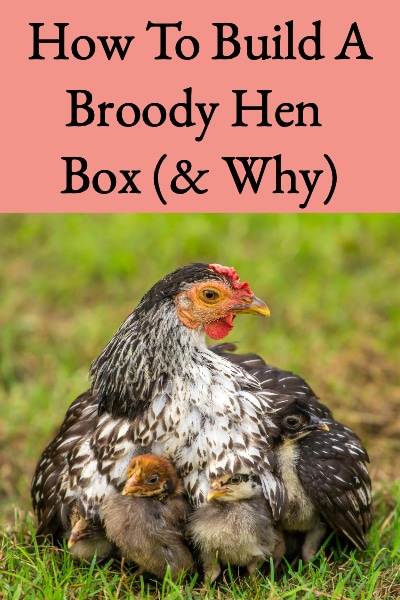
Why Building A Broody Hen Box Is Important
In order for a broody hen to hatch eggs in a coop with a resident flock, it’s generally necessary to move the broody hen to a separate area. Why is this?
- If she stays in a regular next box in the main coop, other hens will get in her nest box when she leaves (she’ll leave once a day to eat, etc.) and lay eggs. These eggs will be at a different development stage than the clutch she’s been incubating and won’t hatch at the same time. Other hens may also break some of her eggs getting in and out of her nest box.
- When she leaves her nest box of incubating eggs she may forget which nest box was hers if there are eggs in other nest boxes. So, she may get on a different group of eggs thereby allowing the original clutch to cool off and die.
- Your broody hen needs her own space to feel safe and secure to do a good job of incubating her eggs. If she’s in a nest box in the main coop with the other hens, she’ll likely spend lots of time trying to defend her eggs and space rather than concentrating on hatching eggs.
- Once her eggs hatch, it’s very difficult for her to defend and protect her chicks from other hens in the coop.
So, it’s better to set up a separate “broody box” either in another area of the main coop or another coop entirely. Since we hoped that several of our hens would eventually exhibit broodiness, we decided to build a semi-permanent broody box in a corner of the main coop.
Why Would You Want A Broody Hen?
If you want more chickens, you have several choices. You can either incubate eggs and raise the chicks that hatch, buy day-old chicks and raise them (see Raising Day-Old Chicks), buy pullets, buy mature birds, or let a broody hen hatch eggs and raise the chicks.
Incubating eggs and raising day-old chicks is a fun project, but it’s a lot of work and you need a good incubator for success. Buying day-old chicks avoids the cost of an incubator but you still have to buy the chicks and then raise them. Buying pullets or mature birds eliminates most of the work of raising chicks, but it gets pretty costly if you want many birds.
So, by far the easiest and most cost-effective way to get more chickens is to let a broody hen hatch eggs and raise the chicks. And, a hen is much better at doing this than we are.
A broody hen’s fluffy butt heats up to the perfect temperature for incubating eggs. She’ll also turn her eggs exactly when needed. And, once they hatch, she’ll take care of all the details on keeping her chicks warm, fed, and watered. Finally, she’ll teach them how to be chickens.
Raising our Buckeyes from day-old chicks was a great experience (see Raising Buckeye Chicks), but I was hoping the Buckeyes would retain their instinct to go broody and raise their own young. I’d rather they perpetuate the flock (why should I do the work if they’ll do it naturally?). So, when one hen showed definite signs of broodiness; Randy quickly constructed a broody box inside the coop (see below).
How To Tell If She’s Broody
In many chicken breeds today, the instinct for raising young has been bred out; because “broodiness” was considered undesirable in factory-laying hens. Some breeds that more frequently exhibit broodiness include:
- Blue-Lace Wyandotte
- Cochins
- Orpingtons
- Red-Laced Wyandotte
- Silkies
Additionally, some of the older heritage breeds still retain these instincts and make good mothers. Buckeyes are a heritage breed, so I was very happy when one of our hens decided she wanted to raise chicks!
As far as broody behavior, we noticed that she seemed to be spending lots of time in the nest box; and then, when we’d try to gather eggs, she’d fluff up and emit a distinctive “growl” that we hadn’t heard from the chickens before. She’d also peck at our hands as we tried to remove eggs.
Then, for two days, she wouldn’t leave the nest box, we were reluctant to put our hand in to retrieve eggs, and even at night – she stayed on the nest and wouldn’t roost – definite indications that she’d gone broody.
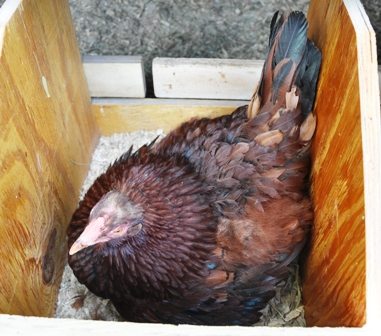
Broody Hen Won’t Leave Nest Box
What’s Needed In A Broody Hen Box?
Besides a nest box within the broody box, the hen needs room to get off the nest and relieve herself; and needs food and water. In order to accommodate all of this, a good size broody box is about 2′ wide x 2 1/2′ long, and it’s a good idea to raise it off the floor to allow for ventilation. A hardware cloth floor is a good idea because it doesn’t collect dust or droppings.
A broody box doesn’t need to be fancy, it just needs to make the hen happy. So, we built the broody box into the back corner of the main chicken coop using scrap lumber and hardware cloth.
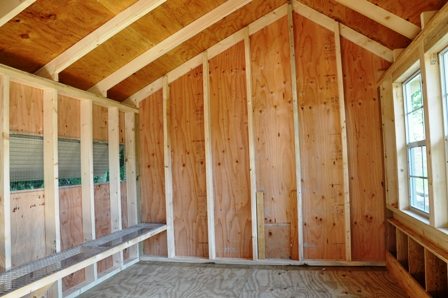
Main Coop Interior Sidewall
We made our broody box 26″ wide x 30″ long x 16″ high and it is raised 14″ off the coop floor. The picture below shows the framing for the broody box.
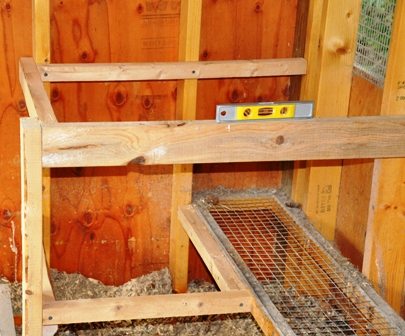
Framing for the Broody Box
We added hardware wire on the bottom (where there wasn’t already hardware wire) so that droppings would fall through.
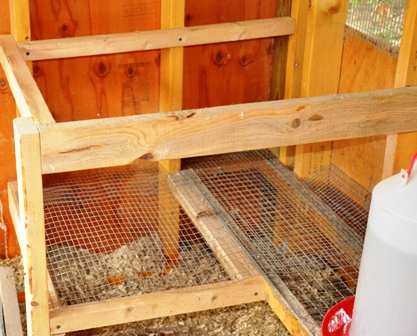
Adding Bottom Hardware Wire
We used wire cloth to wrap the entire “box” except an opening was left so she could access the coop water font, and a solid piece of lumber was used for the top.
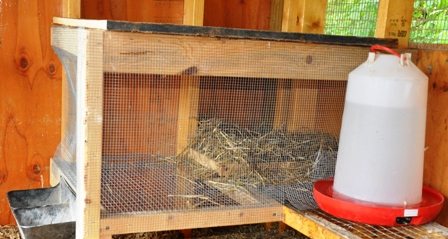
Completed Broody Hen Box in the Coop
After getting the outside structure built, we built a nesting platform inside, put straw in it, and built a “box” around it using cardboard so she’d feel like she was in a regular nest box.
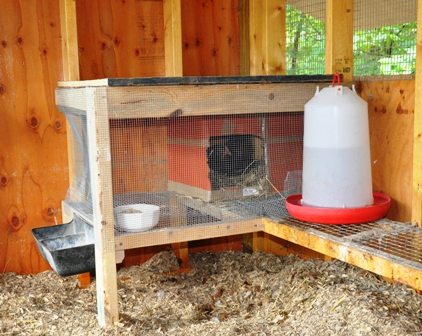
Cardboard “Nesting Box” Added
Moving Broody Hen to the Box
Once the broody box was built, we placed golf balls (to serve as fake eggs) in the nest box and then moved the broody hen into the nest at night.
You want to move a broody hen at night when she’s groggy and sleepy so you don’t upset her and “break” her broody spell.
Also, we used golf balls as fake eggs, but you can use real eggs and that might be the better approach since you want her to remain broody.
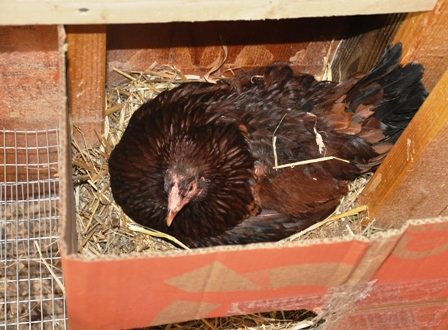
Broody Hen In Her New Nest Box
If a broody hen is really serious, she’ll usually settle into a new nest box within two days. In this case, our first broody hen settled within a day, so we were sure she was pretty serious.
Once you think you’ve got a hen that’s going broody, it’s time to start selecting the fertile eggs that you want her to incubate and hatch (see Collecting & Storing Eggs for Hatching). Typically, these would be from your best rooster mated with your best hens and would be the most uniform/clean eggs you collect.
Since our hen settled so quickly, we placed real eggs that we’d collected under her (again in the night), the next evening. Then, it was just 20 days to hatching! Depending on the size of your hen, you can place 8 to 12 eggs beneath her.
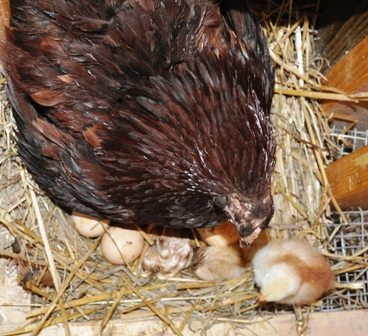
Our First Broody Hen Hatched 3 Chicks
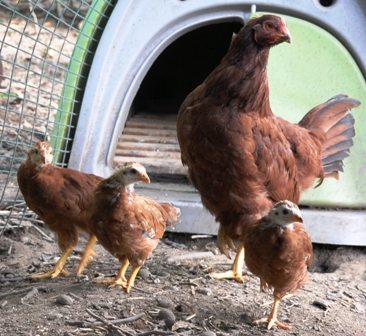
Broody Hen and Chicks
After she hatched her chicks in the broody box, we moved them all into a smaller coop/cage within the larger chicken pasture. She raised three beautiful chickens and I didn’t have to do any of the work!
Grampa says
we had an old red hen that was a good hen that raised many chicks. usually there was no shortage of eggs because many of the younger ones would lay their eggs and then forget about them. as we would collect the eggs for breakfast it was easy to spot new eggs laid that morning. hens that would leave them would already be gone. others that would raise chicks would still be on the nest. we would often take one and give it to “RED”. when no eggs were available we kept an old porcelain doorknob on top of her box that she was happy to sit on it kept her sitting cycle ready for an egg . her box was larger than yours but she was a good size hen. she was responsible for raising most of the chicks. for this their was no question who was head of the pecking order. even the most aggressive rooster left her alone. while books and information like you provide. nothing replaces wisdom. take time to watch the patterns of your hens when something changes it is a signal you may have a problem wisdom comes from using their patterns to keep the flock healthy and productive. the farm provided me with the best years of my life. ———-Grampa—–Thanks for all your knowledge you give us.
Lesa says
Hi Grampa, “Red” sounds like a great hen to have in the flock! I forgot to mention in the post above that once a hen goes broody, she’ll often repeat that behavior 🙂
Carla says
We use an old dog crate, inside the hen house, on cinder blocks, for ours. It works great. No construction, comes out of the coop, for cleaning, and has a removable bottom tray, making cleaning the crate a breeze, and it can be stashed up in the garage, between uses. We will use it if needed for medical isolation, too.
Lesa says
Hi Carla, great idea for making a broody box! Thanks for sharing 🙂
Anne says
Hi Lesa, is it easier / better to let the broody hen raise the chicks? Are the chicks as friendly and easy to handle if the Mama hen hatches them? (compared to the day olds kept warm under a heat source)
Thank you so much for sharing your experiences!
Lesa says
Hi Anne, we’ve raised them both ways, and it is easier to let Mama hen hatch and raise the chicks, but she can only handle a few so if we’re wanting lots of chicks we raise them. We haven’t noticed any difference in how friendly the birds are, if you want them to be friendly they need to be handled & socialized!
Lacey says
Such a good idea. I wish I’d seen this before we put eggs under our broody. She did a great job, but all on her own terms (we thought she would choose to go into the a frame broody coop we had prepared for her and the chicks, and didn’t really know what to do when she decided to plonk herself in the middle of the main coop floor with them instead). It worked out ok despite all that but certainly was not as well planned as yours.
Hooligans7 says
Nice! But I can’t tell from the photos where the actual nesting box is located within the enclosure. Can you describe where it is?
Also, have you had any experience with Barred Rocks becoming broody? I’m hoping some of mine will become mamas one day!
Lesa says
You can see the nest box in the first photo – it’s just a cardboard box in the very far right corner. We haven’t had any Barred Rock hens, just one rooster – so no experience with them going broody. Good Luck – it’s great when they raise their own babies! Oops, I forgot, we did have one Barred Rock hen – she never went broody.
LindaG says
Thank you for the link, Lesa!
LindaG says
Great article. Thanks for sharing this with us. Good luck!
Where did you find your buckeyes, by the way?
Lesa says
Hi LindaG, we got day-old chicks from: http://www.buckeyechickens.com/ We were very happy with them too: ordered 25, received 30 and 28 survived through to adulthood.